
Date :2019-04-10
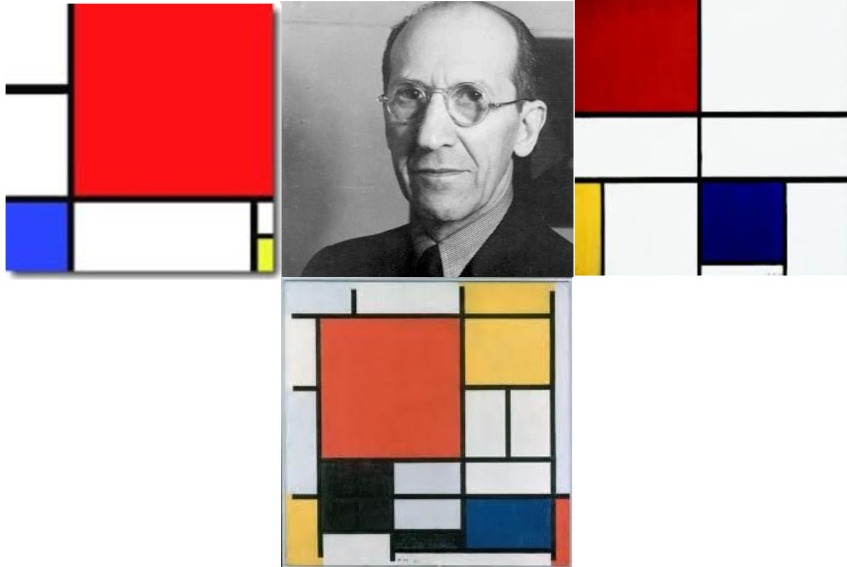
The Dutch Painter Piet Mondrian (1872-1944), is regarded as one of biggest influencers of 20th century art in the west. Though he had never visited India, he was inspired by Annie Besant & he became a member of the Theosophical Society of Netherlands. From the 1920s onwards, this influence was evident in his art, as he radically but methodically simplified the elements of his paintings to reflect what he saw as the spiritual order underlying the visible world. His palette comprised exclusively of black, white and gray, symbolizing the spiritual elements, and of Red, Blue and Yellow that symbolized earthbound elements. Exploring in depth how colour and lines worked together, Mondrian’s art portrayed the relationship between positive and negative elements, the interaction between the multiplicity of creation and spiritual unity to maintain a dynamic balance or unity in diversity.
In 1917, just after the World War I ended in Europe, Mondrian co-founded De Stijl (The Style) modern art movement. This avant-garde movement dedicated itself to creating a utopia through new forms which were pure, simple, universal and harmonic. These visual styles were designed to be appropriate to all aspects of modern life from art to architecture and could be mass produced. Furthering the vision of Mondrian and the co-founders, this implied a reduction to the basic essentials of form and color; by using straight lines, rectangular shapes and primary colours.
The intent and values which formed the basis of Mondrian’s art and his De Stijl movement in Europe, inspired us to incorporate his colourful and meaningful work as the first design theme in the Rohilla Mohalla Project. Traditional artisans of Rampur came together to explore the pure and universal language of the De Stijl movement through their individual craft. At the Rohilla Mohalla Training Centre located in the old quarter of Rampur, violin making artisans worked alongside wooden furniture and carving specialists, paper kite makers and with women skilled at appliqué embroidery to incorporate these global designs in creating unique products.
Under the Mondrian Theme, the following products were designed and manufactured at the Rohilla Mohalla Training Centre:
Training focus:
Date :2019-04-10
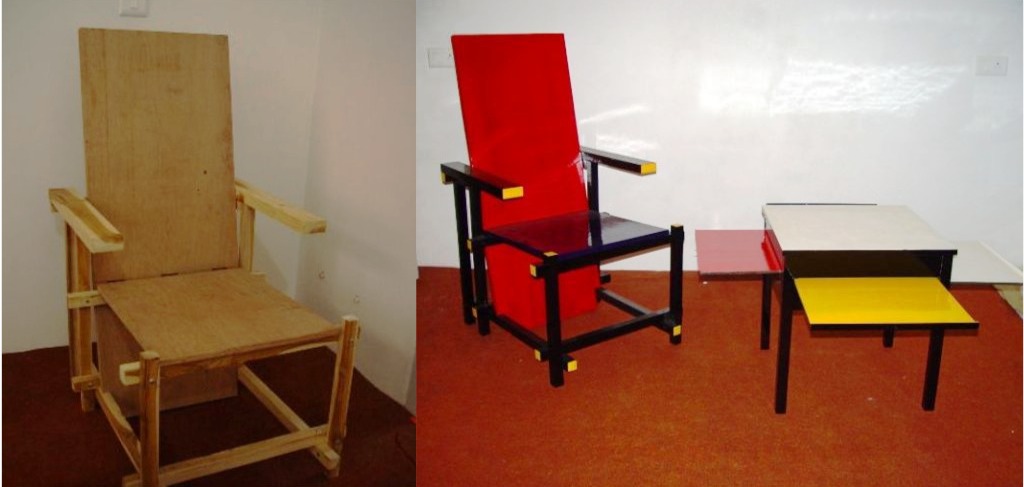
The set of two handmade chairs are inspired by Gerrit Rietveld's Red and Blue Chair designed during 1917-18 as one of the first explorations of the De Stijl art movement in three dimensions. The colour scheme of primary colours (red, blue and yellow) and black was added around 1923. Hoping that much of his furniture would eventually be mass-produced rather than handcrafted, Rietveld aimed for simplicity in production to achieve the greater goal of improving the overall well-being and comfort of a large number of users. The four sided pull-out table painted in primary colours and black and white is inspired by the De Stijl movement, incorporating the ideals of simplicity and functionalism.
Noor Saheb, one of the master-craftsmen in wooden furniture making at Rampur, participated in the Rohilla Mohalla project to understand and recreate these De Stijl inspired furniture sets. His skill acquired a new meaning as he planned for the first time the production of these furniture pieces that were based on modern global concepts, and passed down the wider understanding to new apprentices who joined him from in and around Rampur. The back and the seat of the chair were made using board; and teak wood was used for the arms, legs and other joints of the chair. The four sided pull out table was made in a combination of teak wood and board as well.
In the 1920s, while designing these furniture pieces, Gerrit Rietveld and the other De Stijl designers kept in mind the sizes of boards and wooden planks available in the European market at that time to ensure ease of mass production, moderate costs and functionality in usage; Noor Saheb continued with the same approach – adapting the dimensions to the sizes of wood and board available in Rampur’s wholesale lakkar mandi.
Date :2019-04-10
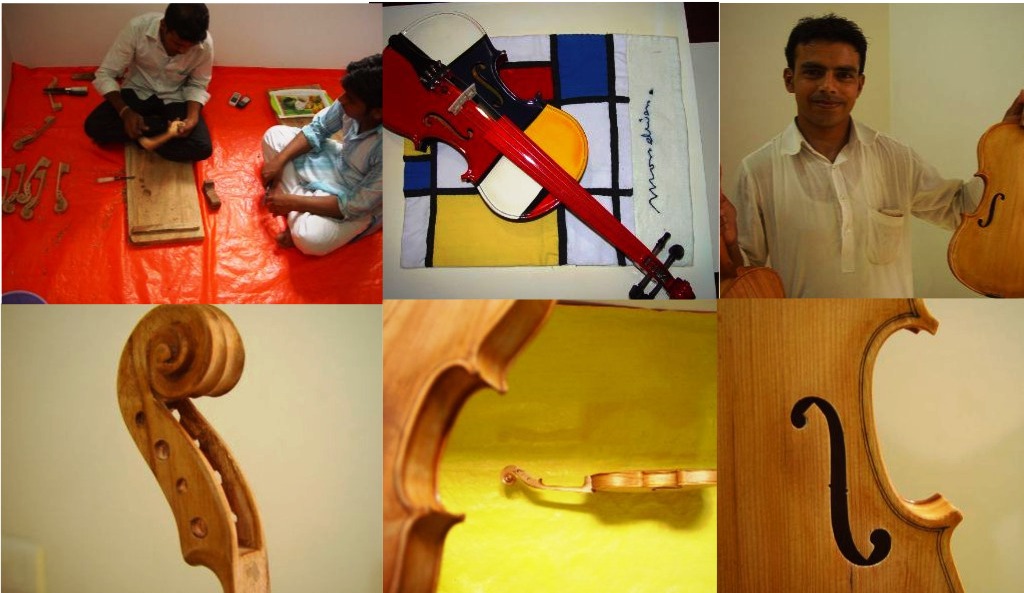
Under the Rohilla Mohalla project, violin making master craftsman Naved proceeded step by step to manufacture by hand a perfectly harmonious sounding instrument. He first carved out the separate sections of the instrument after precise measurement, then brought them together scientifically to complete the assemblage of the violin, and finally finished off by painting the surface of the violin in the visual harmony of Mondrian, as if to further accentuate its harmony in sound. This also added to the aesthetic quality of the violin and to its uniqueness. Violins were painted in one of the three primary colours – blue, red or yellow or in a combination of the three, as shown in the image above, to reflect Mondrian’s iconic works.
Date :2019-04-10
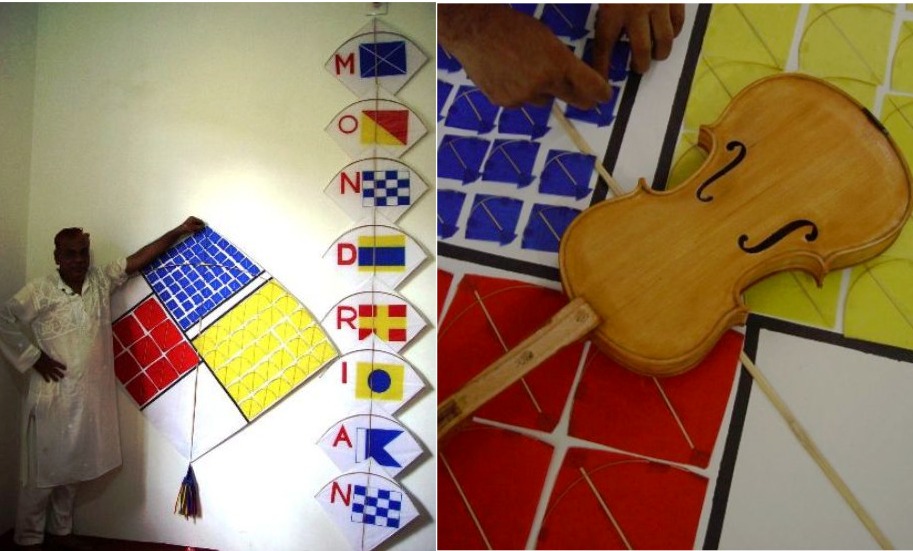
At the Rohilla Mohalla training centre, the father and son kite makers – Asif Miyan (in the picture above) and Touseef Miyan used their craft technique to incorporate the global designs of Mondrian and his De Stijl movement to create visual harmony on decorative kites. A number of miniature kites were made in red, blue and yellow and were pasted onto a large kite to produce a kite collage of symmetric shapes in primary colours. International maritime letter flags was another design theme under the project. Featured in the picture above, are wall hanging decorative kites with “MONDRIAN” illustrated on them using maritime letters. Both these global design themes adapted well to the traditional decorative kite making technique of pasting paper cut outs onto kites.
Date :2019-04-10

This collection of table mats, runners and table covers recreate Mondrian’s celebrated work with primary colours using the traditional appliqué or phool-patti ka kaam that the entire Rampur district is well known for. All the pieces are finished off with an embroidery of the actual signature of the great artist. Applique embroidery is largely done by women, and under the Rohilla Mohalla project, the embroidery artisans got an opportunity to utilise their embroidery and patchwork skills in making home linen which could be used round the year by the urban consumer instead of the season dependant readymade garment orders that they had been fulfilling so far.
Traditionally, appliqué embroidery is done using delicate thinner cloth which folds easily into the desired floral patterns. To ensure durability and functionality, this table linen set is made with the same appliqué technique but by using the best quality thick cotton fabric in non bleeding primary colours. The master craftsperson provided the innovation and training to the embroidery team in adapting the appliqué technique to the new type of fabric and in folding it neatly in straight lines and rectangular shapes instead of curved floral patterns that they were all accustomed to. Measurement was key in the entire process to create visual harmony by learning to accurately / proportionately scale up on paper the Mondrian design from a smaller image that was provided to them, and then transform this larger image onto the cloth as a guide to fulfilling the embroidery pattern.
In the picture above, the children of some of the women from the embroidery team are holding out the table mats and runners embroidered by their mothers.
Date :2019-04-10
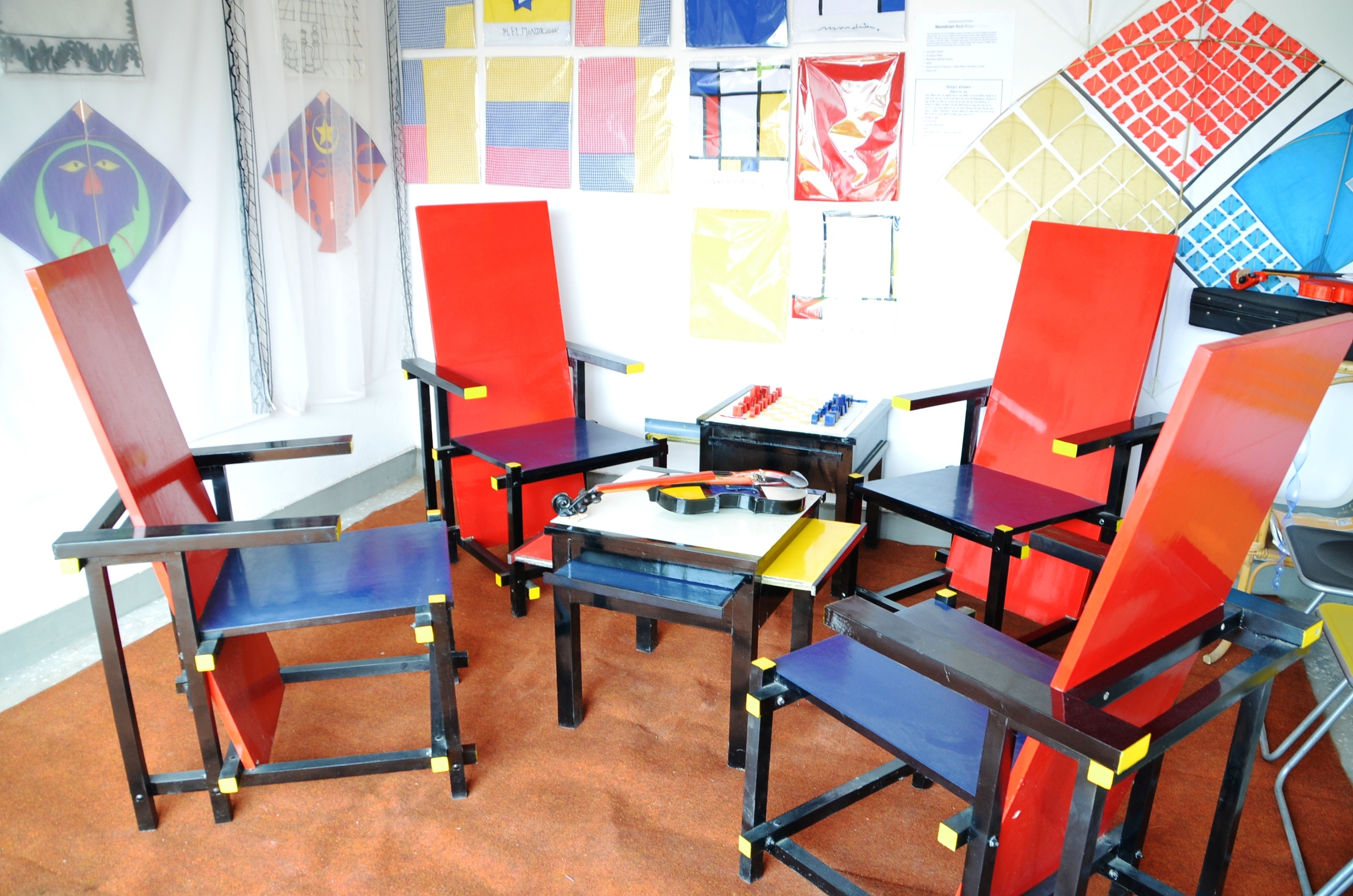
The Rohilla Mohalla Project participated in a handicrafts' fair organized by the Development Commissioner of Handicrafts (UP), that was held in the newly built exhibition grounds in the city of Rampur. Artisans from numerous other districts of Uttar Pradesh were invited to exhibit and sell their artefacts. All the hand made products made by the artisans under the Rohilla Mohalla project were exhibited and viewed by the large number of visitors from Rampur and around. The artisans got an opportunity to explain by themselves the art of Mondrian and how they incorporated his unique designs on Textiles, Paper Kites, Violins and Avant-Garde Furniture.